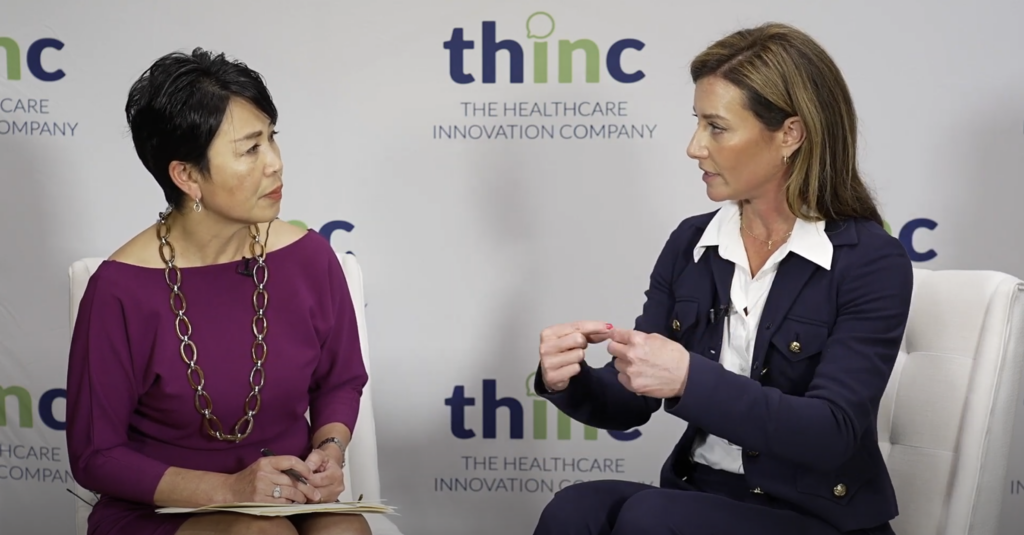Erin Mistry, EVP and Chief Commercial Officer for CorMedix, discusses the groundbreaking advancements in biopharmaceuticals targeting life-threatening diseases. In this interview, Erin Mistry highlights the potential impact of their latest product, DefenCath, on reducing catheter-related bloodstream infections. With promising clinical data and upcoming FDA approval, CorMedix aims to revolutionize treatment for dialysis patients.
You can view the full video interview here
Key Takeaways
- DefenCath’s Impact: DefenCath shows a 71% reduction in catheter-related bloodstream infections, significantly improving patient outcomes.
- Economic Benefits: The product has strong economic data, potentially saving the healthcare system billions in Medicare costs related to dialysis.
- FDA Approval: CorMedix is expecting FDA approval for DefenCath by mid-November, marking a significant milestone for the company and patients.
- Strategic Partnerships: Collaborations with institutions like Boston Medical Center aim to gather data and demonstrate the product’s success, ensuring widespread adoption post-approval.
Introduction to Defencath: An Interview with Erin Mistry
Mabel Jong:
“Hi again, I’m Mabel Jong, and I’m here with Erin Mistry, who is EVP and Chief Commercial Officer for Coremedics. Erin, thank you so much for being here.”
Erin Mistry:
“Thank you for having me.”
Mabel Jong:
“Well, your company is a pharmaceutical, biopharmaceutical company really targeting life-threatening diseases, and you have just made an announcement that you’re really focused on Defencath. Can you talk a little bit about Defencath?”
Erin Mistry:
“Sure. So Defencath is a product that we are commercializing later this year. We are hoping to have our approval around mid-November. We’re an emerging biopharma company.
This is our first product, and our first indication is for patients on hemodialysis that have a central venous catheter. So, when you have a central venous catheter on dialysis, you have two lumens that come out of your body.
This product is a catheter lock solution, so it sits in the lumens and is there in between dialysis sessions. So, the patient does dialysis in the clinic, or they do it in the hospital, and then this product is inserted into the lumen to protect the lumen and the patient from having a catheter-related bloodstream infection.”
Mabel Jong:
“Okay.”
Erin Mistry:
“The product itself, it was the largest clinical study ever done in this patient population for this indication, and it showed a 71% reduction in infections.
The clinical data is off the charts, but we also have very strong economic data around this patient population. One in five Medicare dollars is spent in dialysis and end-stage renal disease.
You think about diabetes populations that roll into end-stage renal disease, most of the Medicare dollars are spent there. We’ve published on 25,000 patients that cost the system over two billion dollars.
Bloodstream infections are severe. If you get one, it’s not a weekend stay. You go into the hospital for a week, maybe two weeks at a time, maybe three weeks, and most of those patients will readmit within 30 days. Most of them have long-term complications. It’s a big burden on the system itself.”
The Prevalence of Bloodstream Infections in Dialysis Patients
Mabel Jong:
“Are bloodstream infections common?”
Erin Mistry:
“They’re very common if you have a catheter. If you’re receiving dialysis on a catheter, keeping it clean and all of those things, it’s actually the number one worry of dialysis patients that have a central venous catheter.
They don’t want to get a bloodstream infection, but when they do happen, they happen very quickly. They happen usually within 90 and 180 days. 50% of them happen within six months. Over 30% happen within a three-month time frame. So, when you do get them, they happen very quickly.”
Traditional Methods for Addressing Bloodstream Infections
Mabel Jong:
“Traditionally, how are they addressed?”
Erin Mistry:
“That’s a great question. Currently, the current standard of care is Heparin, cal-citrate, or saline that’s filled in. You have to lock the lumen with something, so it’s locked with one of those other mechanisms.
They are not broad-spectrum antimicrobial. Defencath is a non-antibiotic antimicrobial lock solution. I want to be clear that it is not a treatment, it is a prevention. Any patient that is on a CVC receiving hemodialysis should be receiving Defencath in the lumen.”
FDA Approval and Partnerships for Defencath
Mabel Jong:
“So, you’ve submitted an application for approval by the FDA?”
Erin Mistry:
“We did.”
Mabel Jong:
“And what are the next steps now? What is the time frame for submitting and then getting it reviewed?”
Erin Mistry:
“Typically, the review process can be anywhere from two months to six months. Because we’ve resubmitted here, we’re looking at a six-month review time frame, which puts us at a mid-November approval date. We feel very confident in that approval time frame.”
Mabel Jong:
“Are there medical centers that are in partnership with testing the product?”
Erin Mistry:
“They’re not testing the product now. We still have to get approval for the product to be used, but we’ve entered into one strategic partnership so far with Boston Medical Center.
They are interested in partnering with us for many reasons, but the first is they want to understand the data better. What is our medical loss ratio for these patients? What’s the health disparities? Many of our patient populations are Black or Hispanic patient populations that are underserved.
We have the data on that in the clinical trials and post, and so we’re looking to gather more data with our partners, and then insert the product and track the same patient population and see what happens after the product is inserted.
It’s kind of baselining it first, then waiting for approval, inserting the product, and then being able to bring those two things together.
We’re looking to get these partnerships, and we have a couple more that we’re hoping to announce later this year to be able to show and demonstrate the product’s success as soon as possible. So, we’re not waiting until approval and then waiting to develop partnerships, which is what many companies do.”
Mabel Jong:
“Potentially, how big a game changer could this be if the FDA decides they would like to approve it?”
Erin Mistry:
“I think there’s a couple of game-changing pieces here. This product is not just with the only indication. The first indication for this is the entire new class of therapeutics. The FDA has never reviewed tarolite.
It’s a combination of tarolite and heparin in the product. The FDA has never reviewed that before, and so we’ve received priority review, new molecular entity designations.
This should hopefully become standard of care, at least in our first indication. Then we have others. Total parenteral nutrition, where you’re receiving food through a feeding tube, oncology is another indication that we have, and then we have pediatric neuroblastoma.
We’re looking at more indications where this mechanism can be used. It should be a big game changer for dialysis patients on CVCs. Just the mortality alone, we can and frankly should be saving lives right now and removing costs out of the system at the same time.”
Coremedics’ Additional Projects and Indications
Mabel Jong:
“Erin, what are other things Coremedics is working on?”
Erin Mistry:
“Beyond the Defencath, it’s the same product, just different indications. Our first study population was done with hemodialysis on CVCs.
The second patient population we’re going to hopefully do an expanded access program with total parenteral nutrition, TPN, that starts in the hospital setting and then moves to the outpatient setting.
Then we have oncology, and like I mentioned, pediatric neuroblastoma. It’s the same product initially, just different indications.”
Experiences and Goals at thINC360 for CorMedix
Mabel Jong:
“So, you’ve had a number of meetings with people here at thINC360. What’s it been like at thINC360? Who are you trying to reach, and are you able to talk to the kinds of people you’d like to speak with?”
Erin Mistry:
“I love this question because we’re really trying to think through commercializing the product differently. When you look at pharmaceutical products that have commercialized in the past, this is how it’s done.
They’ve done different things depending on the disease state, but you hire sales, marketing, market access, all these types of pieces. We’re actually trying to customize the commercialization.
One of the ways to do that is to do organic outreach to these health systems and build the relationships. If you’ve talked to anybody at Coremedics, one of the big proponents that I have hopefully passed along is building deep relationships with people that you want to connect with.
That can be your partners. A conference like thINC360, though, what is so different here is it brings together policy, health systems, payers, and pharmaceutical companies all in one place.
I don’t think you get that at most conferences. Usually, you get health systems, maybe some payers, but you don’t get the breadth here. What I find fascinating about this conference is that we’re able to leverage a big policy play for this product to get used.
It’s a mechanics of the system. It’s a great case study. I’m happy to talk to anybody, but the case study here on the mechanics on the reimbursement of this system between an inpatient setting and an outpatient setting are so different and so complex that we’ve had to explain it to the analysts, we’ve had to explain it to investors, we’ve had to explain it to the street.
It’s difficult, and frankly, we’re spending a lot of money commercially on making sure that the product gets used. The way it gets used is if somebody gets paid for it.
We’ve got the clinical data, now we need the clinical and financial alignment to get a product used. While I was doing consulting work, I’ve seen many products come to market, devices and therapies alike, that if there’s no flow of funds somewhere in the system, that product can be really good but it won’t get utilized.
That’s what we’re trying to do here. We’re trying to mobilize policy because the only way you can take costs out of the system is if the product gets used.”
Mabel Jong:
“Makes sense.”
Erin Mistry:
“This is a great conference to bring all of those facets together, which is rare. That’s why we like it.”
Mabel Jong:
“Erin Mistry, thank you so much.”
Erin Mistry:
“Thank you.”


